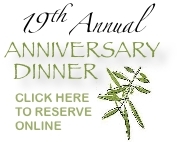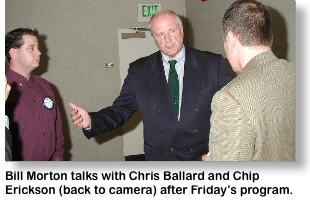|
|
|||||||||||
|
|||||||||||
 |
||||||
|
Vol. 17, No. 16, October 18, 2004 |
||||||
|
|
||||||
|
The Friday Program The Avalanche of Aging
“Bob mentioned that we knew each other from our Xerox days. In fact, the day was September 3, 1974, when I met Bob Vallat”(Bill likes statistics!). He titled his presentation “Demography is Destiny” a quote from August Comte, a 19th Century French philosopher. Bill also quoted Peter Drucker from “The Next Society,” a 2001 publication. Peter F. Drucker is a writer, teacher, and consultant specializing in strategy and policy for businesses and social sector organizations. Morton quoted Drucker from his book, “The Next Society.” He said “The new economy may or may not materialize, but there is no doubt that the next society will be with us shortly. In the developed world, and probably in the emerging countries as well, this new society will be a good deal more important than the new economy (if any). It will be quite different from the society of the late 20th century, and also different from what most people expect.” Morton said that Drucker’s conclusions skimmed over the impact of Global aging the impact of longevity (extending life expectancy), the impact of declining fertility, and the impact of the largest group of baby boomers ever to arrive in retirement. For that matter, the best-selling books of 20 years ago, Megatrends and Future Shock, gave little space to this reality. “I believe that Global Aging is the least explored business opportunity. I call what’s coming as ‘The Longevity Revolution.’ When you compared this new revolution to the Agricultural and Industrial Revolutions, Longevity will be as powerful,” Morton remarked. Looking at available statistics, prior to 200 years ago, only 2-3% of the population lived longer than 65 years. Today, 13.9% of our population is 65 plus. The figure changes every seven weeks! Today’s life expectancy is 77. By the end of the 21st century, you can expect that figure to rise to 123 years! Morton showed current figures exploring two important age groups ... 25-40 and 55-70. He asked, “What will be the difference of percentage change in 2015 for these two groups? The 55-70 group increases 69%, while the 25-40 group will show a decrease of 4%. So, which group would you build your business on?” He asked whether we are approaching our biologic maximum life span, or is it just taking off? “Consider, we have focused more resources fighting disease in the last ten years than in all the last 10 centuries! Research is booming. Previously, people died because they were mis-diagnosed. Now, many of our societies America, Europe, Australia and New Zealand are particularly poised to see a 50-50 chance of their populations living to 100 years. Morton pointed out that it was his opinion that “Geriatric medicine is part of massive denial about aging. There are few educational programs gearing doctors for this important specialty. And, the Media, run by people under 35, don’t live in a world of 50-60-70 and older citizens.”
For years, Japan had been home to the highest percentage of long-lived people. But now, deflation has struck Japan. Their population is decreasing. Where will their workers come from? So, Morton asks, “Global agingÉdoes it matter? I believe it’s the largest challenge for the new millennium. There will be generational tensions, pressure to reduce benefits, a need to raise taxes, and so forth. Financial markets will change perceptibly. Business will be a lot more difficult, unless they look at the opportunity of aging in the next ten years.” There are other considerations. Retirements will be delayed. There will be a new urgency to save. “The Boomers are comingÉ.that group once described as ‘Spoiled Brat Yuppie Scum.’ The Boomers got the short end of the stick. They had the highest SAT scores, but also had the highest flunk-out rate. Schools didn’t plan for them.” But now, there’s a new generation of what Bill calls "second halfers." People 60 and older are returning to school; 70-year-olds are becoming entrepreneurs; 80-year-olds are running marathons; and 90-year-olds are becoming newlyweds. “So, what will we call the 100-year-olds?” (A voice from the back of the room, said “Rotarians!”) Bill was also concerned about the semantics of aging. “The word ‘retired’ just doesn’t work. Neither do ‘retirees.’ Ditto for elders, seniors, mature americans. My personal favorite is ‘Second-Halfers. That expresses the positive outlook of our aging population of them being engaged and contributing for a second time to our society.” Thanks to Bill Morton for an excellent program. His statistics were outstanding and gave his audience a new understanding of what global aging is all about. Thanks to Bob Vallat for his introduction and securing Bill to speak. For his appearance, Bill received a certificate indicating the BBRC has donated 1120 pounds of fresh produce to food banks in the area through Rotary First Harvest. |
IN THIS ISSUE: The Friday Program: The Avalanche of Aging
Rotarian of the Month: Jim Kindsvater
Student of the Month: Josh Hile
Vocational Service Presentation
|
||||||||||||||||||
 |
|||||||||||||||||||
 |
|||||||||||||||||||
 |
|||||||||||||||||||
 |
|||||||||||||||||||
|
CLICK HERE |
|||||||||||||||||||
|
Reveille | Reveille Archives | Meeting Information | Calendar | How to Join the BBRC | Officers & Directors | Committees | Online Member Directory | Short Directory PDF File | Directory Info Form | Set Up User Info | Forgot User Info | Meeting Make-Up Form | Attendance Statistics | New Member Application (PDF File) | Expense-Funding Request Form (PDF File) | Rotary Foundation Pledge Form | District 5030 Website & Newsletter | District 5030 Club Websites & Where-When They Meet | 2003 Raffle Winner | About the Raffle | Email Us
|
|||||||||||||||||||


